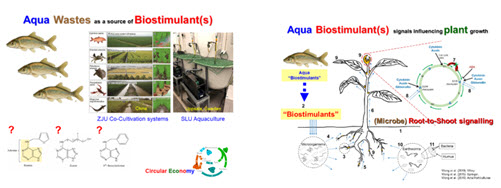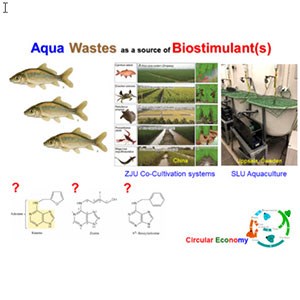Fish wastes contain the essential mineral nutrients (nitrogen and phosphorus) and natural biostimulants (BS) that are required for plant growth. However, its value as organic fertilizers (e.g. BS) and sources of plant nutrients (especially organic aspects of P and N) have not been adequately recognized nor characterised. This project will customise the bio-analytical techniques required for estimating BS in fish wastes.
About half of the world fishes are farmed and aquaculture (AC) is the fastest growing industry around the world. Sweden imports the bulk of her fish requirements and domestic environmental pollution concerns and social sentiments about sustainability curtail the development of AC. A circular economy strategy of integrating fish wastes from AC into the regular fertilizing regimes in plant production represents an effective waste management solution.
Unknown to many, BSs are generally found in animal wastes (including fishes) and they contain plant growth promoting substances like phytohormones (cytokinins, auxins, gibberellins, etc) and these are present in trace levels (usually in the order of micro- to nanograms). Because of these trace levels, extra care and sample preparation are required to ensure minimal analyte loss during extraction, purification and measurement. In addition, past researchers had effectively harnessed recovery markers, like tritium or deuterium-labelled compounds, to account for the loss of analyte.

A careful search of literature revealed that there was no detailed analytical chemical methodologies to handle the brackish to saline matrices during the pre-concentrating process involving Solid Phase Extraction (SPE) other than the monitoring of pH. The earlier proven methods developed by the team were well suited for a low salt environment but not extensively tested under high salt (greater than 25 ppt) or any other complex matrix conditions that these AC-derived samples are likely to pose. Once the SPE protocol has been evaluated and confirmed for a certain type of AC waste, we would then proceed to develop and customize the appropriate sample collection automation step for the various fish species and under different AC systems.
Partners involved
- Jean W.H Yong from the Department of Biosystems and Technology, LTV-faculty, SLU.
- Cecilia Lalander from the Department of Energy and Technology, NJ-faculty, SLU.
- Sammar Khalil from the Department of Biosystems and Technology, LTV-faculty, SLU.
- Sigrun Dahlin from the Department of Soil and Environment, NJ-faculty, SLU.

